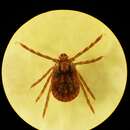en
names in breadcrumbs


Haemaphysalis longicornis, the Asian longhorned tick,[1] longhorned tick,[2] bush tick,[2] Asian tick,[3] or cattle tick, is a parasitic arachnid belonging to the tick family Ixodidae. The Asian longhorned tick is a known livestock pest, especially in New Zealand, and can transmit a disease called theileriosis to cattle but not to humans. However, the tick has been associated with several other tickborne diseases in humans.

An unfed female is typically 2.0–2.6 mm long and 1.5–1.8 mm wide, and grows to 9.8 mm long and 8.2 mm wide with engorgement.[5] Distinguishing a specimen from other members of the genus Haemaphysalis requires microscopic examination of minor physical characteristics.[6]
The Asian longhorned tick is native to temperate areas of East and Central Asia, including China, Korea, and Japan, as well as Pacific islands including Australia, New Zealand, Fiji, and Hawaii, to name a few.[7]
The species was not known to be present on the mainland United States until 9 November 2017, when it was first discovered on a sheep farm in Hunterdon County, New Jersey, although it had been intercepted at U.S. ports on import animals and materials at least a dozen times.[2] The Asian longhorned tick has been found in ten states, including New Jersey, Virginia, West Virginia, North Carolina, Pennsylvania, New York, Arkansas, Maryland, Connecticut, and Ohio.[8][9][10][11] Attempts to eradicate the species from New Jersey failed; the tick successfully overwintered and has since become established in the state as an invasive species.[12][13][14] The tick may have been present in the eastern US for several years, but only recently detected.[10]
The seasonal feeding and reproductive cycle resembles that of other ticks. The tick can reproduce sexually or by an asexual process called parthenogenesis. The latter exist in northern Japan and Russia, whereas the former exist in southern Japan, southern Korea and southern parts of the former Soviet Union. An aneuploid race capable of both sexual and asexual reproduction capability exists in China. Unfed ticks can survive for close to a year, nymphs and adult females the longest, depending on temperature and humidity.[7]: 6–7
The Asian longhorned tick parasitizes mammals and birds. It spreads quickly in farm animals such as cattle, horses, sheep, pigs, and chickens. Natural infestations have been found on wild animals like bear, deer, foxes and hares, small mammals like ferrets and rats, and birds. It has also been found on cats, dogs, and humans. It is believed to migrate by parasitizing birds, which carry it to new areas.[7]: 4
The Asian longhorned tick can transmit an animal disease called theileriosis to cattle, which can cause considerable blood loss and occasional death of calves, but mainly is important to dairy farmers because of decreased milk production and sheep farmers because of decreased wool quantity and quality.[7]: 4–5
Human diseases such as Lyme spirochetes, spotted fever group rickettsiae,[15] Ehrlichia chaffeensis, and Anaplasma bovis have been detected in H. longicornis.[16] It has been associated with Russian spring-summer encephalitis, Powassan virus, Khasan virus, tick-borne encephalitis virus,[7]: 4 Japanese spotted fever,[17] and severe fever with thrombocytopenia syndrome.[12] Human pathogens have not so far been detected in the Asian longhorned tick in the US.[10]
Haemaphysalis longicornis, the Asian longhorned tick, longhorned tick, bush tick, Asian tick, or cattle tick, is a parasitic arachnid belonging to the tick family Ixodidae. The Asian longhorned tick is a known livestock pest, especially in New Zealand, and can transmit a disease called theileriosis to cattle but not to humans. However, the tick has been associated with several other tickborne diseases in humans.
 Unfed female Haemaphysalis longicornis, ventral (underside) view, about 2.3 mm long.
Unfed female Haemaphysalis longicornis, ventral (underside) view, about 2.3 mm long. An unfed female is typically 2.0–2.6 mm long and 1.5–1.8 mm wide, and grows to 9.8 mm long and 8.2 mm wide with engorgement. Distinguishing a specimen from other members of the genus Haemaphysalis requires microscopic examination of minor physical characteristics.
Haemaphysalis longicornis[2] este o specie de căpușe din genul Haemaphysalis, familia Ixodidae, descrisă de Neumann în anul 1901.[3][4] Conform Catalogue of Life specia Haemaphysalis longicornis nu are subspecii cunoscute.[3]
|access-date= (ajutor)Mentenanță CS1: Nume multiple: lista autorilor (link)
Haemaphysalis longicornis este o specie de căpușe din genul Haemaphysalis, familia Ixodidae, descrisă de Neumann în anul 1901. Conform Catalogue of Life specia Haemaphysalis longicornis nu are subspecii cunoscute.
長角血蜱(学名:Haemaphysalis longicornis)为硬蜱科血蜱屬下的一个种。
广泛分布在俄罗斯到东南亚,澳大利亚,新西兰等地。
成虫体长约3毫米,吸血后成虫体长可达到约10毫米*。
日本红斑热,Q(Query)热 (人兽共同感染症),重症热性血小板减少症候群, 以及犬类,牛类感染一种原虫病 (piroplasmia)的媒介等等。
|access-date=中的日期值 (帮助) *山梨県衛生環境研究所(2013)

フタトゲチマダニは、節足動物門鋏角亜門クモ綱ダニ目マダニ亜目マダニ科チマダニ属に属するダニの一種である。 重症熱性血小板減少症候群ウイルス(SFTSウイルス)の宿主の一つでもある[1]。
ロシアから東南アジア,オーストラリア,ニュージーランドにかけて広く分布。日本でも北海道から沖縄県八重山地方にかけて広く分布している。
成虫で体長は約3mmだが、吸血すると約10mmになる[2]。
主な活動期は、5-10月。イネ科植物の茎や葉に生息し、草上で宿主が通るのを待つ。ウシ、ニホンジカ[3]、イヌ、ヒト、鳥類[4]などに寄生し吸血する。吸血できない場合は、約11ヶ月ほどは飢餓状態で生きているが、その後も宿主に遭遇できない場合は餓死する。冬の間は幼虫や成虫の状態で、落ち葉の下などで越冬し、5月頃から活動を始める。[2]
メスは吸血後1ヶ月以内に産卵を行う。1頭のメスが、2000-3000個の約0.3mmになる卵を産む。産卵後、約3日でメスは死ぬ。 ふ化した幼虫は、吸血と宿主からの脱落、脱皮を繰り返し、若虫の時期を経て成虫に成長する。[2]
また、その他にも犬や牛に感染する原虫病の一部(ピロプラズマ症)を媒介する。
작은소피참진드기(Haemaphysalis longicornis)는 진드기의 한 종이다.[1] 라임병과 반점열, 리케치아의 매개체이다.[2] 중증 열성 혈소판 감소 증후군(Severe Fever with Thrombocytopenia Syndrome, SFTS) 바이러스도 매개하는 것으로 나타났다.[3]
과거 작은소피참진드기는 한국, 일본, 중국, 러시아, 오스트레일리아, 뉴질랜드에 서식하며, 국내에서는 부산, 제주, 서울, 경기도등 전국적 분포가 확인되었으나.[4] 2018년도 이후에는 미국에서도 발견되었다.[5] 성충의 몸길이는 약 3밀리미터이지만 피를 빨면 약 10밀리미터까지 커진다.[6]
작은소참진드기를 통해 발생하는 중증 열성 혈소판 감소 증후군은 주로 동북아를 중심으로 발견되고 있다.
중화인민공화국에서는 2007년 5월 ~ 2010년 9월 557명의 환자가 발생하였고 18명이 목숨을 잃었다.[7]
2013년 1월 30일 일본 후생노동성은 야마구치 현의 여성이 이 진드기가 옮기는 바이러스 전염병인 ‘중증 열성 혈소판 감소 증후군’(SFTS)으로 숨졌다고 발표한 이래, 2013년 2월 13일에도 2명이 숨졌다고 발표했다. 사망자는 에히메현과 미야기현에 사는 성인 남성으로 2012년 가을에 사망하였다.[8]
2013년 5월 16일 제주도에서 이 진드기가 옮기는 ‘중증 열성 혈소판 감소 증후군’(SFTS)에 걸려 숨진 것으로 추정되는 환자가 발생하였다. 질병관리본부는 감염 의심 사례가 더 있다고 밝혔다.[9], 또한 제주도에서는 70대 노인이 작은소참진드기에 물려 숨졌다. 대한민국에서는 300명이 입원하여, 1명이 숨을 거둔 셈이다.
작은소피참진드기(Haemaphysalis longicornis)는 진드기의 한 종이다. 라임병과 반점열, 리케치아의 매개체이다. 중증 열성 혈소판 감소 증후군(Severe Fever with Thrombocytopenia Syndrome, SFTS) 바이러스도 매개하는 것으로 나타났다.
과거 작은소피참진드기는 한국, 일본, 중국, 러시아, 오스트레일리아, 뉴질랜드에 서식하며, 국내에서는 부산, 제주, 서울, 경기도등 전국적 분포가 확인되었으나. 2018년도 이후에는 미국에서도 발견되었다. 성충의 몸길이는 약 3밀리미터이지만 피를 빨면 약 10밀리미터까지 커진다.